
Scylla is a main belt asteroid. It was discovered by Austrian astronomer Johann Palisa at the Austrian Naval Observatory on 8 November 1875, and named after the monster Scylla in Greek mythology. Two weeks after its discovery this asteroid became lost and was not recovered for 95 years. It was finally found by Paul Wild of Berne, Switzerland with the aid of an ephemeris created in 1970 by Conrad M. Bardwell at Cincinnati Observatory.
806 Gyldénia, provisional designation 1915 WX, is a carbonaceous asteroid from the outer region of the asteroid belt, approximately 63 kilometers in diameter. It was discovered on 18 April 1915, by German astronomer Max Wolf at Heidelberg Observatory in southern Germany. The discovery observation was ignored for orbital determination, with the first used observation made at Vienna Observatory on 1 May 2015, reducing the asteroid's observation arc by 2 weeks.
862 Franzia is a stony background asteroid from the central regions of the asteroid belt. It was discovered by German astronomer Max Wolf at the Heidelberg-Königstuhl State Observatory on 28 January 1917. The common S-type asteroid has a rotation period of 7.5 hours and measures approximately 28 kilometers in diameter. It was named after the discoverer's son, Franz Wolf.

908 Buda is a background asteroid from the inner regions of the asteroid belt, approximately 30 kilometers in diameter. It was discovered by German astronomer Max Wolf at the Heidelberg Observatory on 30 November 1918. The uncommon L-type asteroid has a rotation period of 14.6 hours. It was named after Buda, the smaller part of the Hungarian city of Budapest.
978 Aidamina, provisional designation 1922 LY, is a dark background asteroid from the outer region of the asteroid belt, approximately 79 kilometers in diameter. It was discovered by astronomer Sergey Belyavsky in 1922, and later named after Aida Minaevna, a friend of the discoverer's family.
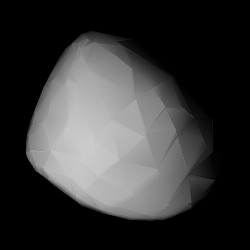
1741 Giclas is a stony Koronis asteroid from the outer region of the asteroid belt, approximately 13 kilometers in diameter. It was discovered on 26 January 1960, by IU's Indiana Asteroid Program at Goethe Link Observatory near Brooklyn, Indiana, United States. It is named for astronomer Henry L. Giclas.
1019 Strackea, provisional designation 1924 QN, is a stony Hungaria asteroid of the inner asteroid belt, approximately 8 kilometers in diameter. It was discovered on 3 March 1924, by astronomer Karl Reinmuth at Heidelberg Observatory in southwest Germany. It is named for German astronomer Gustav Stracke.
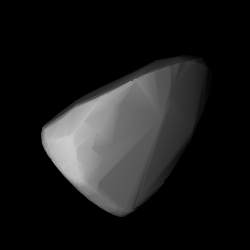
1554 Yugoslavia, provisional designation 1940 RE, is a stony Eunomian asteroid from the middle region of the asteroid belt, approximately 16 kilometres (9.9 mi) in diameter. It was discovered by Serbian astronomer Milorad Protić at Belgrade Astronomical Observatory, Serbia, on 6 September 1940. It was named for the former country of Yugoslavia.

1110 Jaroslawa is a bright background asteroid and rather slow rotator from the inner regions of the asteroid belt. The stony S-type asteroid has a rotation period of 97.4 hours and measures approximately 13 kilometers in diameter. It was discovered at the Simeiz Observatory on the Crimean peninsula on 10 August 1928, by astronomer Soviet Grigory Neujmin, who named it after his son, Jaroslav Grigorevich Neujmin.
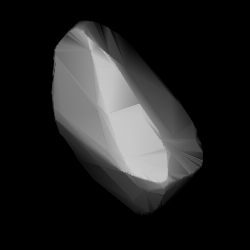
1119 Euboea is a background asteroid from the central region of the asteroid belt. It was discovered on 27 October 1927, by German astronomer Karl Reinmuth at the Heidelberg-Königstuhl State Observatory in southwest Germany. The asteroid has a rotation period of 11.4 hours and measures approximately 30 kilometers in diameter. It was named for the Greek island of Euboea.
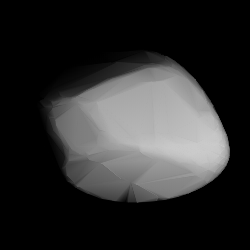
1187 Afra is a dark background asteroid from the central regions of the asteroid belt. It was discovered by German astronomer Karl Reinmuth at Heidelberg Observatory on 6 December 1929. The X-type asteroid has a rotation period of 14.1 hours and measures approximately 32 kilometers in diameter. The origin of the asteroid's name remains unknown.
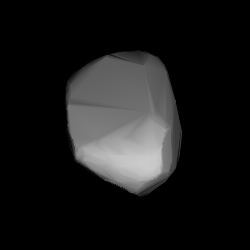
1621 Druzhba, provisional designation 1926 TM, is a stony Florian asteroid and relatively slow rotator from the inner regions of the asteroid belt, approximately 10 kilometers in diameter. It was discovered on 1 October 1926, by Russian astronomer Sergey Belyavsky at Simeiz Observatory on the Crimean peninsula. It was named after the Russian word for friendship.
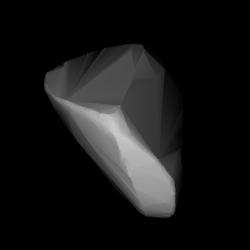
1750 Eckert, provisional designation 1950 NA1, is a stony slow rotating Hungaria asteroid and Mars-crosser from the inner regions of the asteroid belt, approximately 7 kilometers in diameter. It was discovered on 15 July 1950, by German astronomer Karl Reinmuth at Heidelberg Observatory in southern Germany. It was named after American astronomer Wallace Eckert.

1672 Gezelle, provisional designation 1935 BD, is a carbonaceous asteroid from the outer region of the asteroid belt, approximately 27 kilometers in diameter. It was discovered on 29 January 1935, by Belgian astronomer Eugène Delporte at Royal Observatory of Belgium in Uccle, Belgium. It was later named after Flemish poet and Roman Catholic priest Guido Gezelle.
1817 Katanga, provisional designation 1939 MB, is a stony Phocaea asteroid in from the inner regions of the asteroid belt, approximately 16 kilometers in diameter. It was discovered on 20 June 1939, by English-born South African astronomer Cyril Jackson at Johannesburg Observatory in South Africa. It is named for the Katanga Province.

1175 Margo, provisional designation 1930 UD, is a stony background asteroid from the outermost regions of the asteroid belt, approximately 24 kilometers in diameter. It was discovered on 17 October 1930, by astronomer Karl Reinmuth at the Heidelberg-Königstuhl State Observatory in southwest Germany. The meaning of the asteroids's name is unknown.
3873 Roddy, provisional designation 1984 WB, is a stony Hungarian asteroid, Mars-crosser and suspected binary system, from the innermost regions of the asteroid belt, approximately 7 kilometers in diameter. It was discovered on 21 November 1984, by American astronomer Carolyn Shoemaker at the Palomar Observatory in California, United States. It was named after American astrogeologist David Roddy.
1626 Sadeya, prov. designation: 1927 AA, is a stony Phocaea asteroid and binary system from the inner regions of the asteroid belt, approximately 15 kilometers in diameter. It was discovered on 10 January 1927, by Catalan astronomer Josep Comas i Solà at Fabra Observatory in Barcelona, Spain, and named after the Spanish and American Astronomical Society. The discovery of a companion was announced on 1 December 2020.
2995 Taratuta, provisional designation 1978 QK, is a stony Eunomian asteroid from the middle region of the asteroid belt, approximately 17 kilometers in diameter. It was discovered on 31 August 1978, by Russian astronomer Nikolai Chernykh at the Crimean Astrophysical Observatory, Nauchnyj, on the Crimean peninsula. The asteroid was later named after Soviet writer Yevgeniya Taratuta.
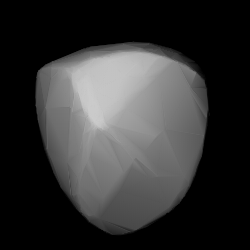
1600 Vyssotsky, provisional designation 1947 UC, is a rare-type Hungaria asteroid and suspected interloper from the inner regions of the asteroid belt, approximately 7 kilometers in diameter. It was discovered on 22 October 1947, by American astronomer Carl Wirtanen at Lick Observatory in California, United States. It was named after astronomer Alexander Vyssotsky.












